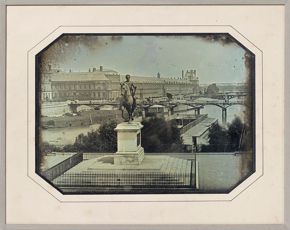Need to Know: 3 Things about “A History of Photography” January 27, 2015

Vincent Chevalier, View of Paris, 1840–41, daguerreotype, the Museum of Fine Arts, Houston, Museum purchase funded by the Brown Foundation Accessions Endowment Fund.
A History of Photography: Selections from the Museum's Collection opens with Vincent Chevalier's View of Paris and William Henry Fox Talbot's Nelson's Column under Construction, Trafalgar Square, London.
William Henry Fox Talbot, Nelson's Column under Construction, Trafalgar Square, London, 1844, salted paper print, the Museum of Fine Arts, Houston, Manfred Heiting Collection, Museum purchase funded by the Brown Foundation Accessions Endowment Fund.
Lewis W. Hine, Newsies, Newark, New Jersey, December 1909, gelatin silver print, the Museum of Fine Arts, Houston, gift of Joan Morgenstern in honor of Isabell Smith Herzstein.
Edward Steichen, Trees, Long Island, 1905, carbon print, the Museum of Fine Arts, Houston, Museum purchase funded by the Long Endowment for American Art and the Sarah Campbell Blaffer Foundation. © Estate of Edward Steichen
Alvin Langdon Coburn, Vortograph, 1917, gelatin silver print, the Museum of Fine Arts, Houston, Museum purchase funded by Alexandra Marshall, the S. I. Morris Photography Endowment, Louisa Stude Sarofim, The Brown Foundation, Inc. courtesy of Mr. and Mrs. M.S. Stude, the Director's Accessions Fund, and friends of the Museum of Fine Arts in honor of the 16th Anniversary of the Photography Department.
Julia Margaret Cameron, Rosalba (Cyllena Wilson), 1867, albumen silver print from glass negative, the Museum of Fine Arts, Houston, Museum purchase funded by the Brown Foundation Accessions Endowment Fund, The Manfred Heiting Collection.
A History of Photography: Selections from the Museum's Collection closes with Thomas Ruff's Carol Pilar.
“View of Paris” possesses an entrancing three-dimensionality akin to that of a modern hologram. —Malcolm Daniel, curator in charge, department of photography and special projects
Daguerreotype may have evolved to digital, and silver prints to selfies, but ever since the invention of photography, one thing remains the same: Photographs are fascinating.
The Museum’s famed photography collection comprises some 30,000 images. When curator Malcolm Daniel came to the MFAH from New York’s Metropolitan Museum of Art about a year ago, he couldn’t wait to share those treasures in a new light.
The result? The exhibition series A History of Photography: Selections from the Museum’s Collection, which offers a new snapshot of the collection every few months. The first rotation is on view now.
Enjoy the View
1) Leading off the installation is View of Paris, a new acquisition that is also the earliest image in the collection. Made barely a year after the invention of photography in 1839, this dramatic daguerreotype showing Paris landmarks is dazzling in its detail. You can use the handy magnifying glass hanging on the wall for an even closer look at the Louvre, the Seine, an equestrian statue of Henri IV, and more.
2) Featured locations span the globe. In addition to France, settings include street life in 1870s London; Edward Steichen's expressive artistry in Trees, Long Island; Malick Sidibé’s look at the exuberant 1960s-era nightlife of Bamako, Mali; and Richard Misrach’s startling 1990 image of Andy Warhol on a bullet-ridden Playboy magazine cover used as target practice at the Nevada nuclear-testing site.
3) Choice portraits of women span the centuries. Julia Margaret Cameron’s pre-Raphaelite–inflected Rosalba and Diane Arbus’s awkwardly elegant Girl in a shiny dress, N.Y.C. were taken exactly 100 years apart, in 1867 and 1967. Lucia Moholy’s 1927 close-up of Bauhaus artist Florence Henri seemed exotic at the time, and still does. Thomas Ruff’s large-scale Carol Pilar, from 1989, closes out the presentation.
Be sure to catch this rotation of A History of Photography before it closes on March 8. Then come see the next group of selections, opening the following week on March 17.





